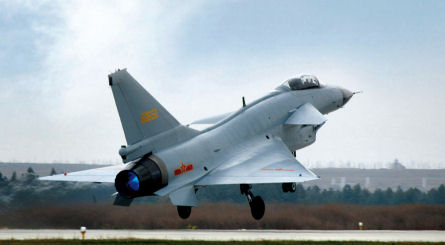China's main priority is to work on and unveil an upgraded version of its Chengdu Aircraft J-10 fighter, with the development of a fifth-generation fighter likely to wait until that is almost completed.
"Research and development is under way to improve the J-10 to develop a more powerful variant," says Wang Yawei, president of AVIC Defence, the military arm of state-owned aircraft manufacturer China Aviation Industry (AVIC). "This will take a bit of time and we are confident we will have a very good fourth-generation fighter when this is completed.
"We will gain a lot of knowledge and information from this development. By focusing on the fourth-generation fighter, we will be able to shorten the time needed to develop a new generation of fighters. After that, we will be able to undertake the development and production of a fifth-generation fighter."
Wang's remarks play down a recent statement by Ho Weirong, deputy commander of the Chinese air force, who said during a television interview that a fifth-generation fighter could be unveiled within 10 years.
China reportedly has several indigenous aircraft programmes under way, including plans for new fourth- and fifth-generation fighters, plus attack and utility helicopters, airborne early warning aircraft, trainers and transport aircraft. Various categories of unmanned air vehicles are also being developed.
 |
|---|
|
|
Wang says the company has state support to develop all of these. AVIC Defence will use the expertise gathered by the separate factories that existed before a reorganisation of the industry in recent years, to make a co-ordinated effort to develop aircraft, he adds.
Exports of the J-10 are also unlikely until the company successfully develops and puts into service an upgraded J-10B in China, says Ma Zhiping, president of China National Aero-Technology Import & Export Corp (Catic), which markets Chinese-made military aviation products globally.
"There is a lot of interest in the J-10 and several countries and air forces have been in touch with us," says Ma. "However, we are not looking to actively market the J-10 until it is sufficiently powerful."
Earlier this month, reports out of Pakistan - a long-time customer of Chinese military aircraft - claimed that the country had signed a memorandum of understanding to buy 36 J-10Bs worth about $1.4 billion. Islamabad is keen on eventually acquiring around 150 J-10Bs, which it will designate as FC-20s, with deliveries to start from 2014-15. The type would supplement its Chengdu/Pakistan Aeronautical Complex JF-17 light fighters and Lockheed Martin F-16s.
"Pakistan is Catic's best friend," says Ma. "It is normal that Pakistan has this desire to procure the J-10. However, we have not signed any deal with anyone yet."
Source: Flight International
















